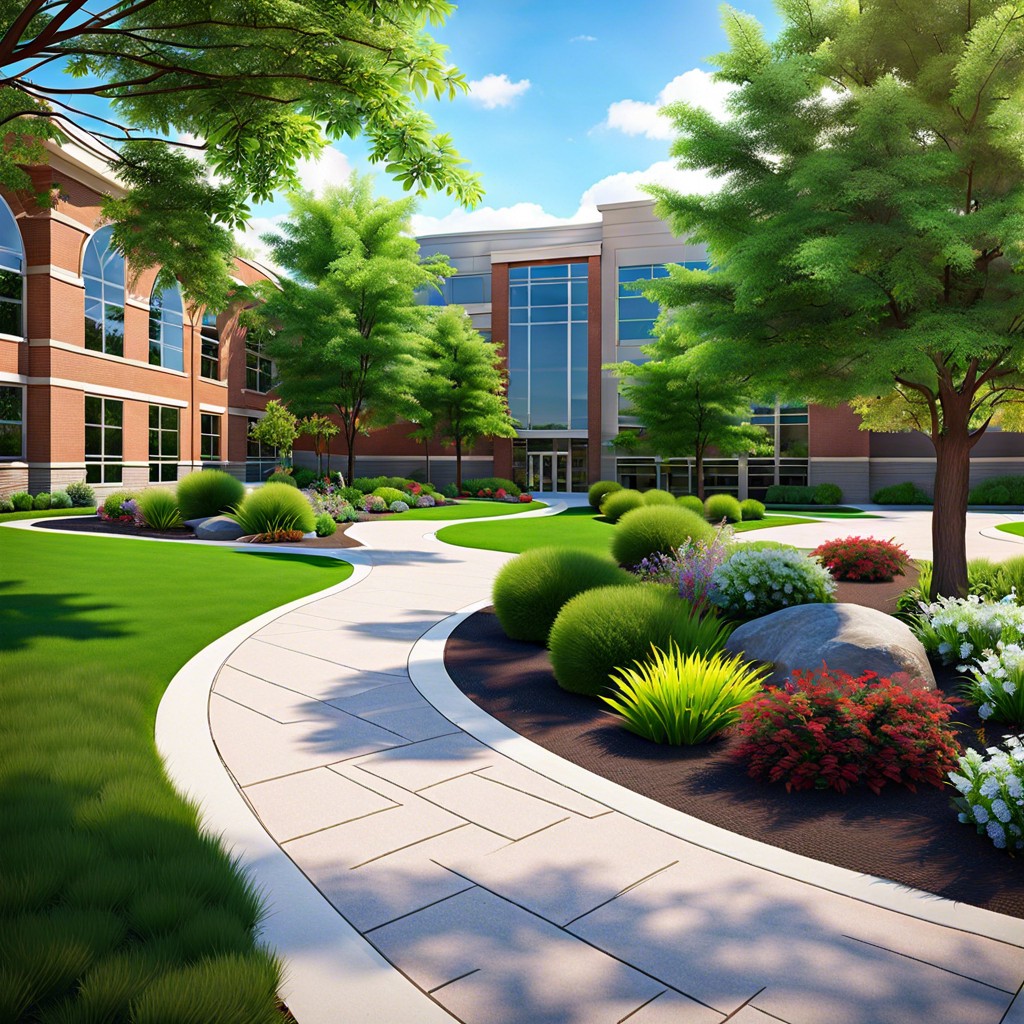Welcome to our comprehensive guide on landscaping company services, where you’ll learn about the various offerings that can transform your outdoor space into a functional and aesthetic paradise.
Key takeaways:
- Wide variety of landscaping services offered
- Benefits of professional landscaping services
- Key elements of a successful landscaping project
- Environmental responsibility in landscaping
- How to contact and engage with a landscaping company
Services Offered

A wide variety of services is typically available to cater to the diverse needs of home and business owners looking to enhance their outdoor spaces. Here are some of the common offerings:
Design and Planning: The first step is often the creation of a custom design tailored to your property and preferences. This includes selecting plants, plotting out hardscapes, and ensuring the design is both beautiful and functional.
Installation: Once the design is finalized, installation teams bring the vision to life. This covers planting trees and shrubs, laying sod or seeding lawns, installing patios and pathways, as well as setting up water features and lighting.
Maintenance: To keep your landscape looking pristine, maintenance services are crucial. This often includes lawn mowing, weeding, fertilization, pruning, and seasonal clean-up activities to manage the health and appearance of your space throughout the year.
Irrigation Systems: Implementing an efficient irrigation system can save time and water. Landscaping companies will install and maintain these systems to ensure your plants receive the right amount of hydration without waste.
Specialty Gardens: For those desiring something unique, you might consider specialty gardens like xeriscapes, which are drought-resistant, or butterfly gardens designed to attract wildlife.
Hardscaping: Beyond plant life, features such as retaining walls, fire pits, outdoor kitchens, and walkways can be constructed to enhance functionality and curb appeal.
Snow Removal and Seasonal Services: In colder climates, many landscape companies offer snow removal services. They also provide seasonal services such as spring or fall cleanups to prepare your landscape for the coming months.
Each service is conducted with an eye for detail, ensuring that your property not only stands out but is a reflection of your personality and lifestyle. A reliable landscaping company can transform an everyday yard into a personal oasis.
Benefits of Professional Landscaping
Professional landscaping services can transform your outdoor space into an extension of your home, providing a beautiful and functional area for relaxation, entertainment, and enjoyment. Here are some compelling benefits:
Enhanced curb appeal: A meticulously landscaped yard presents an attractive appearance, setting a positive tone for visitors and potentially increasing property values.
Customized solutions: Landscapers can tailor designs to fit your specific needs, preferences, and the unique characteristics of your property, ensuring a personalized touch that reflects your style.
Expertise in plant selection: Knowledgeable landscapers choose plants that will thrive in your area, taking into consideration climate, soil conditions, and maintenance requirements.
Time and convenience: By enlisting professionals, you save on the time and effort it would take to do the job yourself, freeing you up for other activities.
Long-term cost savings: Quality landscaping can lead to reduced energy costs through strategic placement of trees and shrubs, as well as savings on water with proper irrigation systems.
Safe and functional outdoor spaces: Landscapers consider safety and accessibility, crafting spaces that are both inviting and compliant with any relevant guidelines or regulations.
Ongoing maintenance support: Many companies offer maintenance services to keep your landscape looking its best year-round, relieving you of the ongoing upkeep.
By investing in professional landscaping services, you can create a captivating outdoor sanctuary that enhances your lifestyle and the beauty of your home.
Key Elements of a Successful Landscaping Project
Realizing the envisioned beauty and functionality of any outdoor space hinges on several critical components. Understanding the client’s preferences stands as a cornerstone, ensuring each design reflects their unique style and meets their practical needs. Comprehensive planning is another crucial aspect, where scale drawings blend aesthetics with the property’s existing structures and natural features.
A well-thought-out selection of plants and materials not only dictates the longevity and sustainability of the landscape but also contributes to an eco-friendly approach through water conservation and the attraction of local wildlife. Such choices also determine maintenance requirements, striking a balance between visual appeal and the homeowner’s ability to upkeep the space.
Soil preparation and irrigation systems are the unsung heroes of a landscaping project. Proper soil treatment provides a strong foundation for plant health and growth, while a well-designed irrigation plan ensures that plants receive the right amount of water without wastage.
Incorporating lighting can elevate the landscape’s ambiance, adding safety and extending usability into the evening hours. Lastly, continuous communication throughout the process ensures alignment with the client’s vision, addressing concerns, and facilitating adjustments as necessary. These elements, when synergized by professional expertise, culminate in a successful landscaping project that gratifies and inspires.
Environmental Responsibility in Landscaping
Incorporating environmentally responsible practices into landscaping isn’t just good for the planet; it can also enhance the beauty and sustainability of your outdoor space. Many companies now prioritize eco-friendly methods which include:
– **Native Plant Selection**: Using plants that are native to the area reduces water use and supports local wildlife, all while requiring less maintenance and fertilizer.
– **Water Conservation**: Implementing smart irrigation systems and drought-tolerant plants can dramatically reduce water usage and help preserve this precious resource.
– **Organic Materials**: Choosing organic fertilizers and pesticides instead of synthetic ones helps to minimize soil and water contamination, protecting the surrounding ecosystem.
– **Recycling Waste**: Whether it’s grass clippings being turned into compost or old hardscape materials repurposed for new projects, recycling waste is a key component of environmental responsibility.
– **Sustainable Design**: Thoughtful designs that take into account the natural layout and existing features of the land can help to reduce the carbon footprint and preserve the natural habitat.
By keeping these points in mind, landscaping companies not only enhance the beauty of their projects but also contribute to the health and well-being of the environment.
How to Contact and Engage With a Landscaping Company
Researching local landscaping companies is the first step. Look for businesses with strong reputations, verified reviews, and a portfolio of completed projects. Once you’ve identified potential candidates, reach out through either their website contact form, email, or by phone to initiate a conversation.
Be clear about your landscaping needs, whether it’s maintenance services, a complete garden overhaul, or something specific like hardscape design. Providing details about your project, including size, scope, and any preferred plants or styles, can help the company assess and meet your needs efficiently.
If possible, schedule an on-site consultation. This allows the landscapers to evaluate the space, discuss your vision in detail, and offer professional insights. During this meeting, ask about timelines, budgets, and any necessary preparations you might need to make before work begins.
Inquire about the company’s communication process. Knowing how they handle updates and feedback ensures you’re involved throughout the project and that any concerns are addressed promptly.
Finally, always discuss and understand the contract and warranty terms before any work commences. It protects your investment and sets clear expectations for both parties. Remember that the best engagement is a partnership based on clear, consistent communication and mutual understanding of the project goals.




